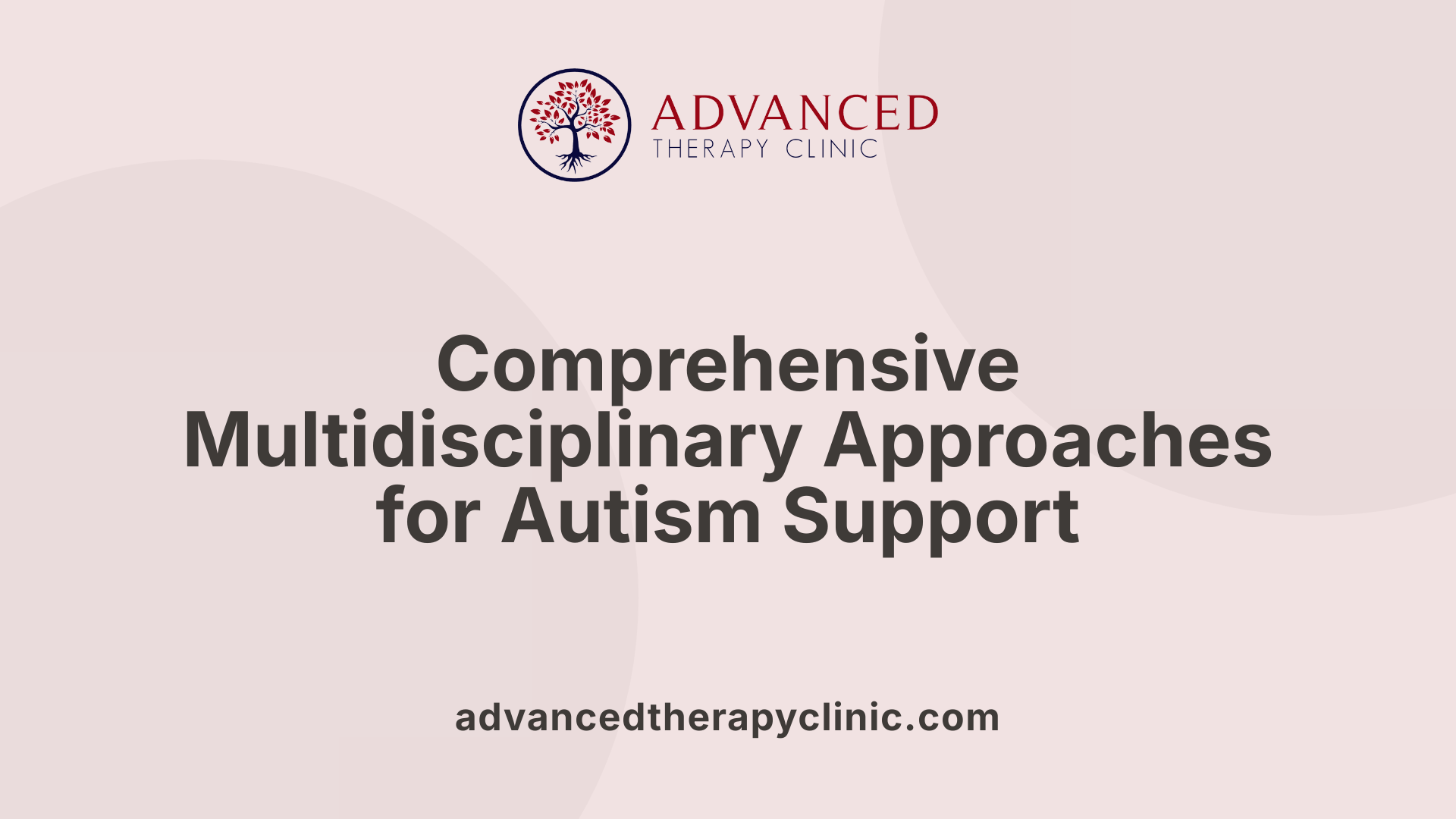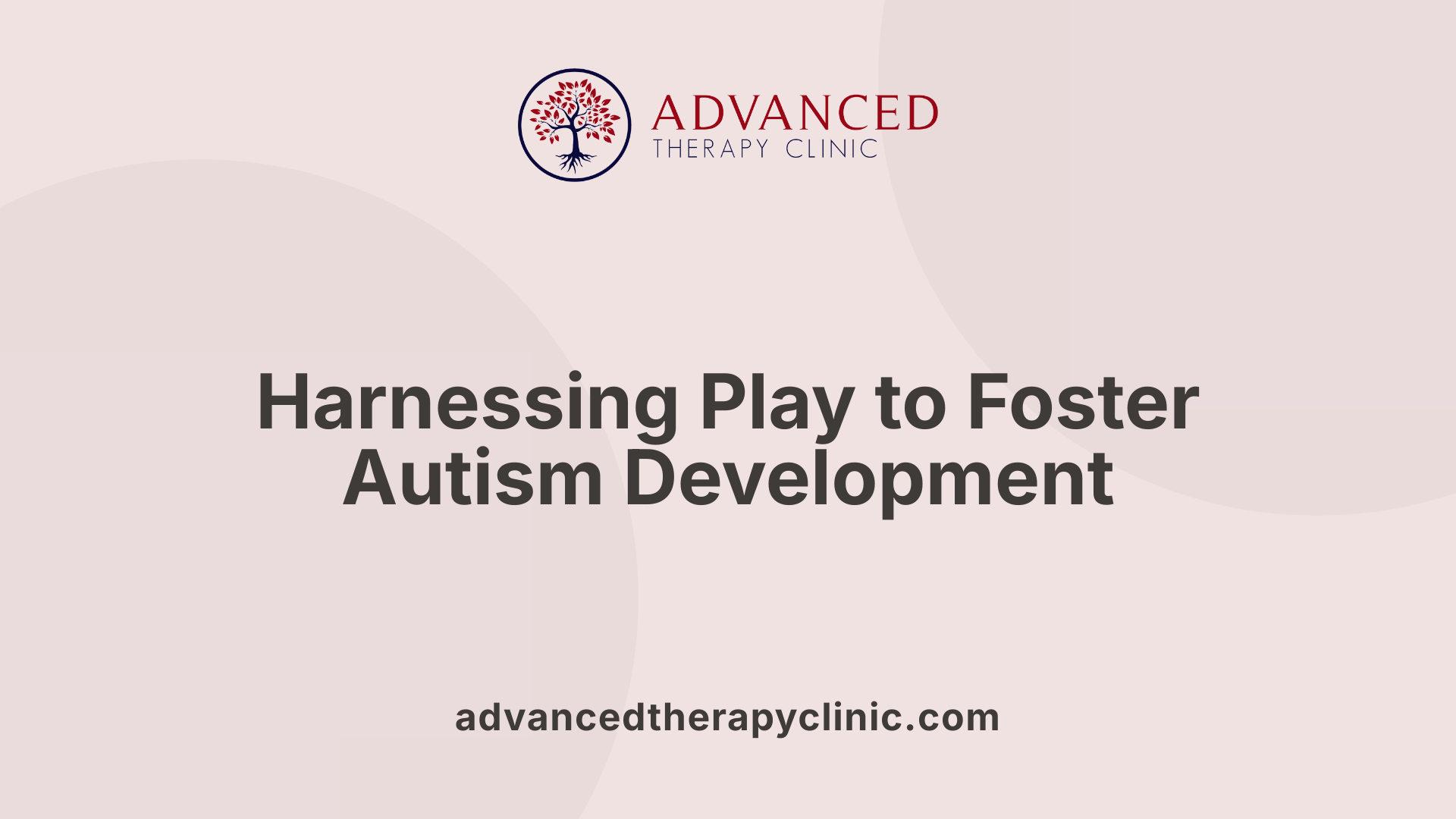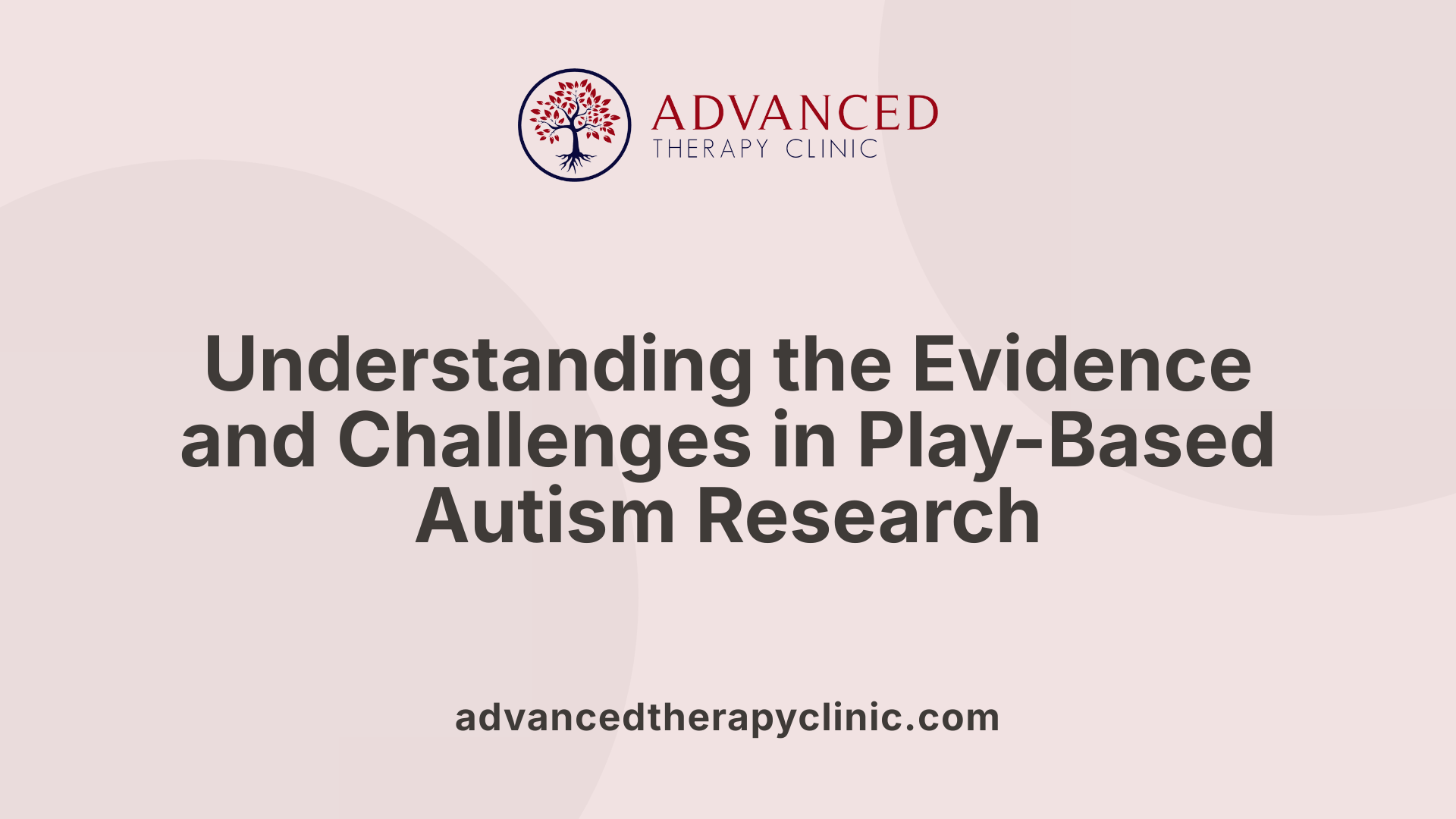Supporting Autism in Mainstream Classrooms


A New Era for Autism Support in Classrooms
As awareness and diagnoses of autism spectrum disorders increase, mainstream classrooms are adopting innovative approaches to support children with autism. This article explores multidisciplinary therapies, early identification, and inclusive educational strategies that empower autistic students to thrive alongside their peers.
The Role of Early Identification and Personalized Therapy

Why is early identification of autism important?
Early identification of autism is crucial because it allows intervention to start as soon as possible, improving developmental outcomes. Pinnacle Blooms Network emphasizes recognizing early signs typically before or around the time children reach preschool age, enabling therapists and families to address challenges proactively.
How are personalized therapy plans developed?
Personalized therapy plans are tailored to each child's unique needs, strengths, and challenges. After thorough assessments, therapists design interventions across various domains such as communication, behavior, motor skills, and social participation. These plans adapt over time to support ongoing development and changing needs.
What role does AI play in therapy adjustments?
The integration of AI technology at Pinnacle Blooms Network allows continuous monitoring and data analysis of a child's progress. This technology helps therapists adjust goals and methods dynamically, ensuring the therapy remains responsive and effective. AI aids in refining strategies to maximize improvement and provide individualized support aligned with each child's evolving requirements.
Personalized early intervention supported by AI-driven adjustments greatly enhances the effectiveness of autism therapies by addressing the diverse and shifting needs of each child.
Pinnacle Blooms Network: A Leader in Autism Therapy

Range of Therapies Offered
Pinnacle Blooms Network provides a comprehensive suite of autism therapies designed to support children with autism and sensory conditions. Their services include Applied Behavior Analysis (ABA), speech therapy, occupational therapy, special education, psychological counseling, and various behavioral therapies. This multidisciplinary approach ensures holistic development focusing on speech, occupational skills, behavior, and social inclusion.
Therapy Delivery Scale and Success Rates
The organization has impressively delivered over 6.3 million therapy sessions, achieving a proven improvement rate exceeding 97%. Such high success underscores their commitment to personalized therapy plans. These plans are dynamically adjusted through AI technology, enabling tailored support as a child's needs evolve over time.
Nationwide and International Presence
Pinnacle Blooms Network boasts a robust presence with more than 1,600 certified therapists operating across 100+ centers throughout India and abroad. Their extensive network facilitates access to quality autism therapies, making early intervention and ongoing support accessible to a wide population. This widespread footprint helps empower children to become self-sufficient and integrate successfully into mainstream society.
Multidisciplinary Therapies Supporting Autism Development

What therapies are included in a multidisciplinary approach for autism?
Pinnacle Blooms Network provides a comprehensive range of therapies to support children with autism, including ABA therapy, speech therapy, occupational therapy, psychological counseling, and behavioral therapies. These interventions work together to promote overall development in areas such as communication, behavior, social skills, and self-sufficiency.
How does ABA therapy contribute to autism intervention?
ABA (Applied Behavior Analysis) therapy is a highly researched method with over 50 years of proven effectiveness. It focuses on improving communication, social skills, and adaptive learning through strategies like Discrete Trial Training (DTT), Natural Environment Training (NET), and Pivotal Response Training (PRT). Early ABA intervention, starting as young as 18 months, builds foundational skills critical for classroom participation and behavioral regulation.
What role does speech therapy play?
Speech therapy targets language development and communication challenges often faced by children with autism. It is essential for children with conditions like selective mutism or pragmatic language difficulties. Speech-language pathologists work with children using assessments, observations, and tailored interventions to improve verbal skills and reduce anxiety around communication.
How does occupational therapy support children with autism?
Occupational therapy addresses sensory processing, motor skills, and functional daily activities. It helps children become more independent and adaptable in various environments by developing skills needed for self-care, play, and participation in social settings.
How are psychological counseling and behavioral therapies integrated?
Psychological counseling supports children and families in managing anxiety, emotional challenges, and social inclusion. Behavioral therapies use evidence-based strategies to reduce anxiety and encourage positive behaviors. Pinnacle Blooms Network emphasizes personalized therapy plans that are continually adjusted using AI technology, ensuring that interventions evolve with the child’s needs.
Is nutrition therapy part of this approach?
While nutrition therapy is not explicitly listed among the primary services offered by Pinnacle Blooms Network, multidisciplinary autism care often benefits from nutritional considerations to support overall health and development.
Together, these therapies form a multisensory, multidisciplinary approach that focuses on early intervention and personalized strategies to help children with autism lead fulfilling, independent lives in mainstream society.
ABA Therapy: Evidence-Based Intervention in Schools
What is ABA Therapy?
Applied Behavior Analysis (ABA) therapy is a well-established, research-backed approach for autism intervention with over 50 years of proven effectiveness. It focuses on improving communication, social skills, and adaptive learning abilities through structured behavioral techniques tailored to each child's needs.
Key Components of ABA Therapy
ABA therapy incorporates several core methods, including:
- Discrete Trial Training (DTT): A highly structured technique that breaks down skills into small, teachable steps reinforced through repetition and rewards.
- Natural Environment Training (NET): Emphasizes teaching skills in real-world, everyday settings to encourage natural use and generalization of learned behaviors.
- Pivotal Response Training (PRT): Targets pivotal areas like motivation and response to multiple cues, aiming to produce broad improvements across different skill domains.
Focus on Communication and Social Skills
ABA therapy primarily aims to strengthen essential communication and social interaction skills. Through individualized plans, children learn to express needs effectively, engage with peers, and develop self-regulation strategies. These improvements support their inclusion and successful participation in school and community environments.
In school settings, ABA techniques are often integrated into Individualized Education Plans (IEPs), helping customize learning experiences and behavioral supports. Collaborative efforts among educators, therapists, and parents enhance ABA implementation, fostering consistent application of strategies across classroom and home contexts.
Incorporating ABA Into Individualized Education Plans (IEPs)

How is ABA used in Individualized Education Plans (IEPs)?
ABA therapy plays a crucial role in developing Individualized Education Plans (IEPs) tailored to children with autism in school environments. By integrating ABA principles, educators create structured, data-driven plans that address each child's unique needs. These plans focus on measurable outcomes, ensuring consistent progress tracking.
How does ABA tailor learning experiences for children with autism?
ABA's flexibility allows IEPs to include personalized skill goals, such as communication, social interaction, academic performance, and behavior regulation. Techniques like Discrete Trial Training (DTT), Natural Environment Training (NET), and task analysis are deployed within classroom activities. This individualized approach supports each child’s learning style and pace, helping them engage more effectively in their educational setting.
How does incorporating ABA improve communication, social, and academic skills?
Incorporating ABA within IEPs targets practical communication skills, enabling children to express needs and participate actively in class. Social skills, such as peer interaction and cooperative play, are enhanced through consistent behavioral interventions. Academic abilities benefit from tailored instruction and reinforcement strategies that promote focus and task completion. Furthermore, ABA fosters behavioral self-regulation and smooth transitions between activities, contributing to overall classroom success.
Effective collaboration among educators, therapists, and families ensures that ABA-based IEPs offer comprehensive support. Regular team meetings, shared resources, and consistent reinforcement between school and home environments contribute to meaningful improvements in children's educational and social outcomes.
Collaborative Strategies Among Educators, Therapists, and Families
How do team collaboration and regular meetings support ABA implementation?
Effective collaboration among educators, therapists, and families is vital in implementing Applied Behavior Analysis (ABA) therapy in school settings. Regular team meetings create a platform where all parties can discuss a child's progress, share observations, and adjust intervention plans as needed. This collective approach ensures that therapy goals remain aligned and that any challenges are proactively addressed.
What role does resource sharing play in collaborative autism support?
Resource sharing between teachers, therapists, and families enhances the consistency and quality of support provided to children with autism. Sharing materials, strategies, data from therapy sessions, and educational tools allows each stakeholder to reinforce learning and behavioral goals effectively. This unified approach fosters skill generalization and smoother transitions between home and school environments.
Why is consistent support essential for ABA therapy success?
Consistency in applying ABA strategies across home, school, and therapy contexts strengthens the child's ability to acquire and generalize new skills. Consistent support ensures that behavioral plans and teaching techniques are delivered uniformly, reducing confusion and enhancing the child's learning outcomes. Families and educators working closely with therapists create a dependable environment that nurtures development and independence.
Together, these collaborative strategies form the backbone of successful ABA intervention in educational settings, enabling children with autism to thrive academically, socially, and behaviorally.
Addressing Selective Mutism Within the Autism Spectrum
What Is Selective Mutism and How Does It Present?
Selective mutism is an anxiety disorder marked by a child's difficulty in speaking in certain social situations despite being able to speak comfortably in others. This condition predominantly affects pragmatic language, meaning communication is situational rather than universal. Children with selective mutism often remain silent in environments like school but may talk freely at home or with familiar people.
When Is Selective Mutism Typically Diagnosed?
The disorder generally emerges between the ages of 3 and 6 years, aligning with key social and language development phases. It is often recognized when children start school and their inability to speak in this new setting becomes noticeable to teachers and peers.
How Does Selective Mutism Relate to Autism?
Selective mutism frequently co-exists with autism spectrum disorders since both involve challenges with communication, social interaction, and anxiety. Children with autism may display selective mutism symptoms alongside broader sensory and behavioral difficulties. Effective assessment and intervention require a multidisciplinary team approach, including speech-language pathologists, psychologists, and educators, to tailor personalized therapy plans that address the child's unique needs. Understanding this relationship is crucial to providing targeted therapies that support verbal communication and reduce anxiety across varied social contexts.
Assessment Approaches for Selective Mutism in School Settings
Interdisciplinary Screening and Evaluations
Assessment of selective mutism in schools involves a collaborative, interdisciplinary approach. Professionals such as speech-language pathologists, psychologists, and educators join forces to conduct screening and comprehensive evaluations. This teamwork ensures varied perspectives on the child’s communication challenges and anxiety-related behaviors.
Speech and Language Assessments
Central to diagnosis are detailed speech and language evaluations performed by speech-language pathologists. These assessments examine pragmatic language skills and the child's capacity to communicate in different settings. Standardized tests help evaluate verbal abilities, while other observational methods monitor the child’s spontaneous speech behaviors.
Parent and Teacher Input
Input from parents and teachers is crucial during the assessment process. Their observations provide insights into the child's communication patterns across home and school environments. Teachers can describe behaviors during classroom activities, while parents can note comfort levels and speech tendencies in familiar settings.
Stress Reduction During Assessments
Since children with selective mutism experience anxiety, assessment procedures emphasize reducing stress. Modifications include creating a comfortable environment, incorporating play or familiar activities, and using video recordings to observe speech without putting the child on the spot. This supportive approach helps obtain a more accurate understanding of the child's abilities.
Therapeutic Interventions for Selective Mutism
What Behavioral Therapies Are Used for Selective Mutism?
Behavioral therapies form a cornerstone in treating selective mutism, especially approaches like stimulus fading and exposure therapy. Stimulus fading gradually introduces a child to anxiety-provoking communication situations by starting with familiar, less stressful settings and slowly progressing to more challenging ones. Exposure therapy similarly helps reduce fear by gently encouraging communication in varied environments, supporting the child's increasing verbal participation.
How Does Augmentative Communication Support These Children?
Augmentative communication techniques are vital for children who struggle with verbal expression due to anxiety. This approach includes tools and methods such as picture exchange systems or communication devices that offer alternative ways to communicate. It helps reduce pressure on spoken language while fostering interaction and participation, enabling children to express their needs comfortably and build confidence.
What Is the Role of Self-Modeling in Treatment?
Self-modeling involves children observing recordings or live demonstrations of themselves successfully communicating. This technique encourages them to emulate positive behavior and builds self-efficacy. By seeing themselves overcome communication challenges, children can internalize effective strategies and reduce anxiety associated with speaking.
How Do Developmental Approaches Like DIR Floortime Help?
Developmentally based interventions such as DIR Floortime focus on building emotional and social connections through play and interaction tailored to the child's developmental level. This approach supports communication growth by encouraging engagement, emotional regulation, and social skills through natural, child-led activities. It prioritizes individualized therapy that adapts to the child’s evolving needs.
Integrated Strategy for Effective Intervention
Effective treatment for selective mutism involves combining these methods with interprofessional collaboration among speech-language pathologists, psychologists, educators, and families. This integrated approach ensures that strategies reduce anxiety, improve verbal communication, and help generalize skills across settings with consistent and supportive intervention.
Importance of Interprofessional Collaboration in Autism Support
Roles of Psychologists, Psychiatrists, Teachers, and Family in Autism Support
Effective support for children with autism involves a collaborative team of professionals and family members. Psychologists and psychiatrists contribute by addressing the mental health and behavioral aspects, offering assessments and therapeutic interventions. Teachers provide critical insights from the educational environment, adapting instruction and classroom strategies to meet individual needs. Families offer invaluable context about the child's history, behavior patterns, and personal strengths, ensuring a comprehensive understanding that guides therapy.
Coordinated Intervention for Better Outcomes
Interprofessional collaboration allows for coordinated assessment and treatment planning, ensuring all perspectives are integrated. For example, speech-language pathologists work closely with behavioral therapists and educators to design personalized strategies that align speech and behavioral goals. This team approach also facilitates continuous adjustments to therapy plans, leveraging tools like AI to track progress and adapt interventions as a child's needs evolve.
Improving Communication and Reducing Anxiety
Collaboration among professionals promotes consistent and supportive strategies to reduce anxiety and improve verbal communication, especially in conditions like selective mutism. By sharing observations and progress, the team can apply behavioral therapies (such as stimulus fading and reinforcement) effectively across settings. Families play a vital role in generalizing skills beyond therapy sessions, helping children to use communication skills confidently in everyday environments.
Together, these interdisciplinary efforts foster a nurturing framework where children with autism can develop self-sufficiency, engage socially, and achieve meaningful progress in communication and behavior.
Play-Based Interventions: Foundations and Focus

How is play used as a natural context for intervention in autism therapy?
Play serves as a foundational context for early childhood interventions, particularly because it is an engaging, natural activity for young children. Practitioners across different disciplines harness play to promote developmental goals within a fun and motivating environment. This setting encourages children with autism to practice and enhance critical skills in a less structured, more child-led manner, which can foster better engagement and learning.
What is the association between social play and developmental outcomes?
Social play is strongly linked to the development of social skills, language, and communication abilities. Many autism therapies focus specifically on social play as a means to teach and reinforce these skills. Through playful interactions with peers and adults, children learn turn-taking, understanding social cues, expressing themselves, and other pragmatic language components essential for everyday communication.
How diverse are the approaches within play-based interventions?
A significant review of 388 studies on play-based interventions for children aged 2 to 8 years revealed a highly diverse landscape of therapeutic approaches. These include:
- Feedback-based methods: Offering parent or caregiver feedback to promote skill development.
- Behaviorist-influenced interventions: Utilizing structured methods like reinforcement.
- Developmental relationship-based models: Such as DIR/Floortime, focusing on emotional and relational growth.
- Peer-mediated or group play techniques: Encouraging interaction within social settings.
This diversity reflects differing philosophies and practices, from more directive behavioral techniques to naturalistic, relationship-driven strategies. However, the broad variability and small participant sizes in many studies highlight the need for more consistent evidence to guide practitioners and families.
| Aspect | Detail | Implications |
|---|---|---|
| Natural Context | Play provides an enjoyable, low-pressure setting | Encourages child-led learning and motivation |
| Developmental Impact | Social play linked to social, language, and communication skills | Primary target for many interventions |
| Intervention Diversity | Includes behaviorist, developmental, feedback, and peer methods | Reflects varied therapeutic philosophies and needs |
| Research Challenges | Heterogeneity and small sample sizes in studies | Calls for consolidation and stronger evidence base |
Frameworks to Evaluate Play-Based Interventions
What is the role of play in therapy?
Play serves multiple roles in autism interventions. It can act as the primary context in which social and communication skills are naturally developed. Sometimes, play functions as the mechanism through which therapeutic change occurs, engaging children in meaningful interaction. In other cases, play is one component within a broader, more comprehensive treatment approach, providing opportunities for practicing skills in a fun and supportive environment.
How do philosophical underpinnings shape play-based interventions?
Play-based therapies often draw from different philosophical foundations. Behaviorist approaches emphasize structured environments where play is used to reinforce desirable behaviors through repeated practice and positive reinforcement. On the other hand, developmental approaches view play as a dynamic, child-led process fostering relationships, emotional expression, and social understanding. For example, DIR/Floortime is a developmental-based therapy focusing on emotional connections through play, contrasting with behaviorist methods that prioritize measurable behavior change.
What is the practitioner's role and what intervention formats exist?
The practitioner's role varies widely depending on the approach and setting. In some interventions, practitioners coach parents to provide feedback and support naturalistic play at home, making parents active collaborators in therapy. Other therapies utilize individual or group sessions with therapists directly engaging children in structured or semi-structured play. Peer-mediated methods involve other children to promote social interaction, while some strategies focus on small groups to enhance social play skills collectively. These diverse roles and formats address the varied needs of children with autism, allowing tailored interventions based on individual strengths and contexts.
The Evidence Base and Limitations in Play-Based Autism Research

How large and robust are the studies on play-based autism interventions?
Current research on play-based interventions for children with autism predominantly consists of small-scale studies. Approximately half of these studies involve 10 or fewer participants, and only about 21% qualify as randomized controlled trials (RCTs), the gold standard for rigorous research. This limited scale and design variety pose challenges in drawing firm conclusions about the effectiveness and generalizability of these interventions across broader populations.
Are there concerns regarding the representation of diverse groups in these studies?
Yes, a notable under-representation of girls and minority groups exists in play-based intervention research. Since the majority of studies focus on children with autism without balanced demographic representation, findings may not fully reflect the unique needs and responses of these underrepresented populations. This gap highlights the importance of inclusive study designs that consider diversity in gender and cultural backgrounds.
What challenges exist in consolidating the evidence from play-based intervention research?
The heterogeneous nature of the literature complicates evidence consolidation. Variations in intervention types, philosophical underpinnings (behaviorist versus developmental), and practitioner roles create complexity in comparing outcomes across studies. Furthermore, differing methodologies and small sample sizes hinder establishing consistent conclusions or best practices, indicating a clear need for more methodologically robust and diverse research in this field.
Promoting Social Inclusion Through Sensory and Behavioral Therapies
What are multi-sensory approaches in autism therapy?
Multi-sensory approaches in autism therapy involve engaging various senses such as touch, sight, sound, and movement to support a child’s learning and development. At Pinnacle Blooms Network, therapists utilize these strategies to enhance speech, occupational skills, and social behavior. By stimulating multiple senses, children can better process information and improve communication and social interaction.
How do behavioral therapies improve social skills?
Behavioral therapies, including Applied Behavior Analysis (ABA), focus on modifying behaviors to encourage positive social interactions. Therapies like Discrete Trial Training and Pivotal Response Training target communication, self-regulation, and social responsiveness. These approaches use reinforcement and gradual exposure to social situations, helping children reduce anxiety and become more comfortable engaging with peers.
How does therapy support integration into mainstream society?
Therapies aim to equip children with autism to live fulfilling lives as active members of mainstream society. Personalized therapy plans, often aided by AI to adapt to each child’s needs, focus on developing independence, social inclusion, and participation in everyday activities like school and community events. Collaboration among therapists, educators, and families ensures that children receive consistent support to generalize learned skills across different settings, fostering confidence and belonging.
Development of Speech and Occupational Skills for Classroom Success
How Does Speech Therapy Benefit Children with Autism?
Speech therapy plays a crucial role in supporting children with autism by targeting communication challenges. It helps improve verbal and nonverbal communication skills, enabling children to express their needs and participate more fully in classroom activities. Tailored interventions can address issues such as selective mutism by reducing anxiety around speaking and gradually increasing verbal interactions in safe and familiar settings. Speech-language pathologists collaborate with educators and families to create supportive environments that encourage consistent language use and social interaction.
What Are the Goals of Occupational Therapy in Autism?
Occupational therapy focuses on building the skills necessary for daily living and academic success. Therapists work on improving fine motor skills, sensory integration, and adaptive behaviors that contribute to a child's independence and confidence in the classroom. By addressing sensory conditions and helping children navigate challenges related to attention, self-regulation, and motor coordination, occupational therapy facilitates smoother transitions between activities and environments, supporting overall school participation.
How Do These Therapies Support Functional and Academic Skills?
Both speech and occupational therapies emphasize personalized, multidisciplinary approaches tailored to each child's unique needs. These interventions support foundational skills like communication, behavioral self-regulation, and participation in classroom routines. Integrated into Individualized Education Plans (IEPs), therapies help children with autism develop social skills and manage academic demands effectively. Collaboration among therapists, educators, and families ensures consistent support, helping children generalize learned skills across home and school settings for meaningful participation and success.
| Therapy Type | Focus Areas | Classroom Impact |
|---|---|---|
| Speech Therapy | Verbal communication, pragmatic language, anxiety reduction | Enhances participation, reduces selective mutism, improves social communication |
| Occupational Therapy | Sensory integration, motor skills, daily living activities | Supports independence, behavior regulation, and engagement in classroom tasks |
| Combined Approach | Personalized strategies, multidisciplinary collaboration | Promotes holistic development and academic readiness |
Managing Behavioral Self-Regulation and Transitions at School
How does ABA therapy support behavior regulation in children with autism?
ABA therapy is a well-established, research-backed approach that helps children with autism improve behavioral self-regulation. Techniques such as Discrete Trial Training (DTT), Natural Environment Training (NET), and Pivotal Response Training (PRT) are implemented to promote meaningful behavior change. These interventions focus on teaching children skills to manage their actions effectively and respond appropriately to different social and academic situations.
What strategies assist children in managing transitions at school?
Transitions can be challenging for children with autism due to changes in routine and environment. ABA-based behavioral plans provide support by teaching coping strategies, using visual schedules, and gradually introducing changes to reduce anxiety. Consistency and individualized approaches developed by therapists, teachers, and parents help children adjust smoothly between activities, classrooms, or settings.
In what ways is classroom participation improved through ABA?
Applying ABA principles in school enables personalized learning experiences by targeting communication, social skills, academic performance, and behavioral regulation. Individualized Education Plans (IEPs) crafted with ABA techniques foster skill-building aligned with each child's needs. Interventions encourage active engagement in class through reinforcement of positive behaviors, and adaptation of classroom environments to support inclusivity and participation.
Collaboration enhances ABA effectiveness
Successful implementation of ABA in school settings relies on effective collaboration among educators, therapists, and families. Regular team meetings, shared resources, and coordinated support ensure consistency in behavioral strategies and skill development. This teamwork helps children generalize their skills across different settings, promoting greater independence and success in the classroom.
Nutrition Therapy and Its Role in Autism Support
What is Nutrition Therapy in Autism?
Nutrition therapy involves the strategic use of diet and nutritional interventions to support the health and development of children with autism and related sensory conditions. Although not directly highlighted by Pinnacle Blooms Network, integrating nutritional support can complement therapies like ABA, speech, and occupational therapy by addressing underlying physiological needs.
How Does Nutrition Therapy Impact Sensory Conditions and Behavior?
Children with autism often experience sensory sensitivities and behavioral challenges related to digestion, food preferences, or intolerances. Proper nutrition therapy aims to:
- Address gastrointestinal issues that may exacerbate sensory sensitivities or irritability.
- Provide balanced diets to support brain health and emotional regulation.
- Reduce nutritional deficiencies that could impact cognitive and behavioral functioning.
By improving physical well-being through targeted nutrition, behavioral improvements and increased participation in therapy sessions may be observed.
How is Nutritional Support Integrated into Therapy Plans?
Personalized therapy plans, such as those pioneered by Pinnacle Blooms Network, can incorporate nutritional assessments alongside speech, behavioral, and occupational therapies. Key steps include:
- Conducting dietary evaluations and identifying food sensitivities or deficiencies.
- Collaborating with dietitians and therapists for a multidisciplinary approach.
- Adjusting nutritional strategies as children’s needs evolve, potentially supported by AI-driven monitoring.
- Supporting families with guidance on meal planning and addressing feeding challenges.
This close integration helps create a holistic care plan geared towards self-sufficiency and inclusion.
Overall, combining nutrition therapy with established intervention methods enriches the support system for children with autism, emphasizing the importance of individualized and comprehensive care.
Technology and AI Enhancing Autism Therapy Adaptations
How is AI used to monitor and adjust therapy plans?
At Pinnacle Blooms Network, innovative AI technology plays a vital role in monitoring the progress and adjusting autism therapy plans over time. By continuously analyzing data from therapy sessions, AI helps therapists identify subtle changes in a child's behavior, communication, and skill levels.
This real-time monitoring enables the detection of areas requiring more focus or modification, ensuring interventions remain highly effective. Such data-driven insights allow for proactive adjustments instead of waiting for periodic manual evaluations, promoting smoother developmental trajectories.
How do personalized interventions evolve with a child's needs?
Personalization is central to effective autism therapy. Therapies at Pinnacle Blooms are tailored to suit each child's unique abilities and challenges.
Thanks to AI, these personalized strategies are dynamic rather than static. As a child develops new skills or faces emerging difficulties, therapy goals and techniques are recalibrated promptly. This means the support adapts in sync with the child’s growth, whether improving speech, social behaviors, or occupational skills.
This continuous evolution fosters a more responsive environment where therapy remains relevant and maximizes progress. Parents and therapists can collaborate closely, backed by AI-generated reports that highlight strengths and areas needing additional support.
Leveraging AI technology for ongoing, personalized adjustments helps children with autism receive the right intervention at the right time, promoting independence and social inclusion.
Challenges Faced by Schools in Providing Autism Support
Diversity in Autism Presentation
Autism presents in a wide range of ways across different children, affecting communication, social skills, sensory processing, and behavior uniquely in each individual. Such diversity makes it challenging for mainstream schools to adopt a one-size-fits-all approach. Personalized interventions, like those offered by Pinnacle Blooms Network, emphasize tailored therapy plans, but implementing similar customization in schools requires specialized knowledge and adaptive strategies.
Resource Limitations
Many schools struggle with limited access to resources essential for comprehensive autism support. This includes shortages of trained therapists, insufficient availability of therapy sessions, and lack of specialized equipment for sensory and behavioral therapies. While networks like Pinnacle Blooms operate over 100 centers with 1,600 certified therapists across India and beyond, most mainstream schools cannot match these capacities, leading to gaps in consistent therapy and support.
Need for Therapist and Teacher Training
Effective autism support in schools relies heavily on collaboration among educators, therapists, and families. However, many educators lack in-depth training on autism-specific interventions such as ABA therapy, speech therapy, and behavioral management. Enhancing teacher preparedness through targeted training programs can improve implementation of Individualized Education Plans (IEPs) and incorporation of strategies like Discrete Trial Training (DTT) or Natural Environment Training (NET). Interprofessional teamwork remains vital to bridge knowledge gaps and sustain supportive learning environments.
Schools face multifaceted challenges when seeking to provide effective autism support. Addressing these issues requires improved teacher training, increased resource allocation, and adoption of personalized, evidence-based interventions fostering inclusive and adaptive school settings.
Building Therapist Capacity and Certification Standards
Why is having certified therapists important in autism care?
Certified therapists ensure high-quality, evidence-based intervention for children with autism, promoting better developmental outcomes. Their expertise supports personalized therapy plans tailored to individual needs, enhancing overall effectiveness and trust in the therapy process.
What training and qualifications do therapists typically undergo?
Therapists specializing in autism therapies usually receive specialized education in Applied Behavior Analysis (ABA), speech therapy, occupational therapy, or psychology. Training includes coursework, supervised clinical experience, and certification exams such as those for Board Certified Behavior Analysts (BCBA). Ongoing professional development, including workshops on emerging techniques and interprofessional collaboration, is critical to maintain competency.
How do large therapy networks aid in deploying qualified therapists?
Networks like Pinnacle Blooms Network facilitate wide access to certified therapists by organizing over 1,600 professionals across more than 100 centers nationally and internationally. These networks streamline recruitment, training, and quality assurance processes, offering consistent therapy standards. Additionally, the use of AI-driven personalized plans within such large systems allows therapists to continually adapt interventions based on evolving child needs, maximizing therapy outcomes.
| Aspect | Details | Impact on Autism Therapy |
|---|---|---|
| Therapist Certification | Involves specialized training and certification exams | Ensures proficiency in evidence-based methods |
| Professional Development | Ongoing education and skill enhancement | Maintains high standards and introduces new techniques |
| Network Scale & Reach | Deployment of therapists across multiple centers | Expands access to care and standardized best practices |
| Technology Integration | AI-powered adjustments to therapy plans | Enables responsive, individualized interventions |
International and Pan-India Outreach for Autism Therapy
Expansion of Therapy Centers
Pinnacle Blooms Network has established a significant footprint with over 100 centers across India and abroad. This expansive presence ensures that families from diverse geographic locations can access specialized autism therapies, including ABA, speech, occupational, and behavioral therapies. With over 1,600 certified therapists, the network is equipped to deliver personalized and high-quality interventions tailored to each child's evolving needs.
Accessibility of Therapies in Diverse Regions
By operating numerous centers PAN India and internationally, Pinnacle Blooms Network improves accessibility for children with autism and sensory conditions regardless of their location. The network's integration of AI technology helps streamline therapy plans and enables real-time adjustments, making effective support more widely available. This approach addresses the challenges faced by families living in remote or underserved areas.
Importance of Scalable Autism Support
Scalability is central to Pinnacle Blooms Network's mission to deliver consistent and individualized autism therapy. Their model demonstrates how combining a vast network of therapists with technology supports early identification and intervention—critical factors in achieving meaningful developmental gains. The wide reach and adaptable therapy delivery systems help ensure that more children can become self-sufficient and socially included while leading fulfilling lives.
Case Examples of Success Through Therapy Networks
Statistics on Therapy Sessions and Improvement
Pinnacle Blooms Network has delivered over 6.3 million therapy sessions, demonstrating extensive reach and impact. Remarkably, their data shows a proven improvement rate exceeding 97%, highlighting the effectiveness of their multi-disciplinary, personalized autism therapies. This high success rate reflects the network's focus on early identification, individualized therapy plans, and continuous adjustments using AI technology.
Impact Stories of Children Reaching Self-Sufficiency
Children supported by Pinnacle Blooms Network have progressed significantly towards self-sufficiency, with many integrating smoothly into mainstream society. Therapies encompassing ABA, speech, occupational, and behavioral interventions empower children to develop essential communication, social, and adaptive skills. Families often share transformative stories of children who, once struggling with sensory and communication challenges, now participate confidently in school, social settings, and daily life activities. Such outcomes underscore the network’s commitment to fostering fulfilling lives through compassionate and evidence-based care.
Integrating Therapy into Classroom Routines and Activities
Embedding Therapy Techniques During Class Time
Integrating therapy within classroom activities allows children with autism to engage in learning without interruption. Techniques like Applied Behavior Analysis (ABA) can be seamlessly woven into daily lessons through methods such as Discrete Trial Training (DTT) and Natural Environment Training (NET). These strategies enable targeted skill development—communication, social behavior, and adaptive learning—in contexts that are meaningful and familiar to the child.
Supporting Natural Learning Environment
A natural learning environment is critical for generalizing skills beyond therapy sessions. Incorporating play and social interactions during class helps children practice communication and social skills organically. Using student interests as motivators enhances engagement and fosters a supportive atmosphere where progress can flourish.
Teacher Facilitation of Therapy Goals
Teachers play a pivotal role in carrying forward therapy goals. They collaborate closely with therapists to understand individualized plans and adapt classroom routines accordingly. Regular team meetings and resource sharing ensure that behavioral strategies and skill-building exercises are consistently reinforced. With teacher support, therapy interventions become sustainable parts of the school day, promoting inclusion and active participation for children with autism.
Parental Involvement as a Cornerstone of Effective Support
How Does Parental Training Empower Families?
Training and empowering parents is crucial in autism support. Parents are taught strategies that help them understand their child's unique communication and behavioral needs, enabling consistent reinforcement of skills learned during therapy. This empowerment fosters confidence and promotes a nurturing environment that complements professional interventions.
What are Collaborative Care Models in Autism Therapy?
Collaborative care models involve a close partnership between parents, therapists, educators, and medical professionals. This teamwork ensures a unified approach to the child's development, allowing for shared insights and tailored strategies that are adapted continually as the child's needs evolve. Such models encourage open communication and shared decision-making.
How is Skill Reinforcement Managed at Home and School?
Effective autism support relies on the consistent reinforcement of skills across settings. Therapists collaborate with parents and teachers to create individualized plans that maintain continuity between home and school environments. This includes regular updates, shared progress monitoring, and consistent use of behavioral techniques, ensuring skills generalize to everyday life and social interactions.
Future Directions in Autism Support Within Education
How Can Research Methodologies Be Enhanced in Autism Education Support?
Improving research methodologies is crucial for advancing autism support in education. Current studies often involve small participant groups—about half with 10 or fewer children—and only 21% are randomized controlled trials (RCTs). Strengthening study design, increasing sample sizes, and focusing on rigorous, controlled trials will provide more reliable evidence for effective interventions.
How Can Diversity and Inclusion Be Increased in Autism Studies?
Research currently under-represents girls and minority groups with autism, limiting the understanding of diverse needs. Future studies should aim for greater inclusion across gender, ethnic, and socioeconomic backgrounds. Increasing diversity will ensure therapies and educational approaches are tailored to a wider population, promoting equity in support and outcomes.
How Can Technology and Multidisciplinary Approaches Be Leveraged?
Organizations like Pinnacle Blooms Network demonstrate the power of integrating AI technology with personalized and adaptive therapy plans, allowing dynamic responses to a child's evolving needs. Multisensory, multidisciplinary approaches involving educators, therapists, parents, psychologists, and speech-language pathologists form a collaborative foundation for success. Leveraging technology alongside team-based strategies enhances individualization, supports early identification, and optimizes intervention efficacy.
Overall, future directions in autism support within education emphasize robust, inclusive research combined with innovative, technology-driven, and collaborative methods to empower children with autism to thrive academically and socially.
Moving Towards Inclusive and Empowering Classrooms
Supporting children with autism in mainstream classrooms requires a holistic and collaborative approach involving early identification, personalized multidisciplinary therapies, and the integration of evidence-based interventions such as ABA and play-based therapies. With ongoing advances in technology and research, alongside dedicated networks of certified professionals and engaged families, mainstream education can become a nurturing environment where autistic children thrive socially, academically, and emotionally. The convergence of therapy and education holds the promise of true inclusion and self-sufficiency for every child on the spectrum.
References
Recent articles

Speech Therapist Online
Bringing Communication Therapy to Your Screen: The Rise of Online Speech Services

How to Train Your Child to Use a Speech Device Effectively
Empowering Communication: Guiding Your Child to Master Speech Device Use

Adapting Speech Devices for Children with Unique Needs
Enhancing Communication: Innovations and Insights in AAC for Children with Special Needs

What Are the Needs of a Person with Autism
Understanding the Comprehensive Support Needs of Individuals with Autism

Risperidone for Autism
Navigating Behavioral Management in Autism with Risperidone

Do Amish Kids Get Autism?
Exploring Autism Prevalence Among Amish Children: Facts and Insights


